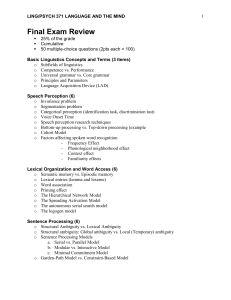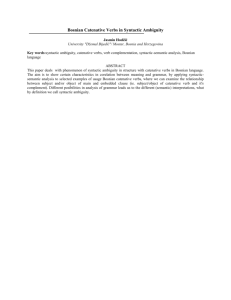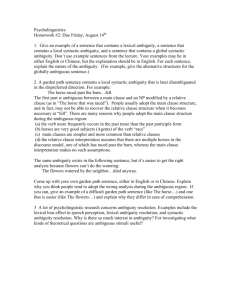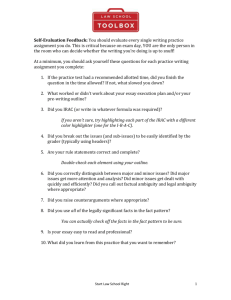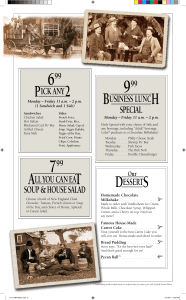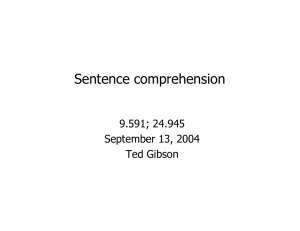Syntax 1
advertisement
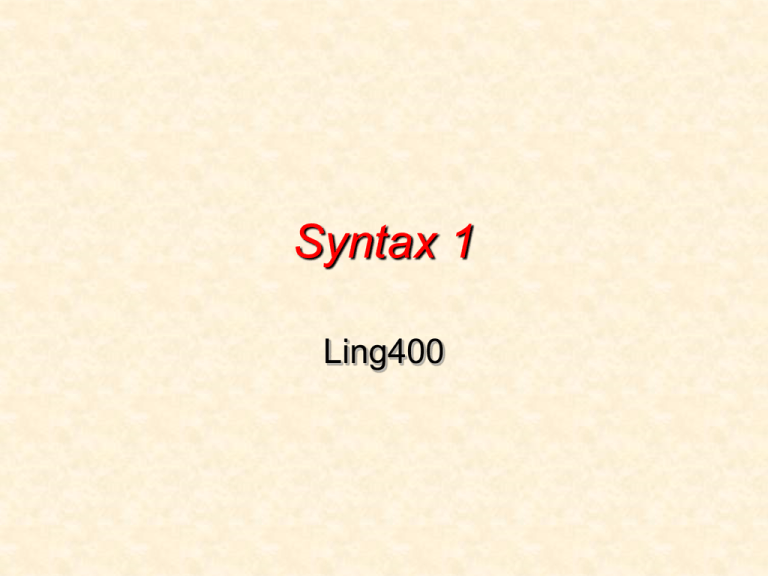
Syntax 1 Ling400 What is syntax? • the study of the internal structure of sentences: how to put together words to form sentences • Noam Chomsky’s theory of syntax: accounts for the productivity of our utterances in terms of structure-building rules (phrase structure rules) Chomsky’s Thesis • We can utter and/or understand an infinite number of sentences. • We can do this despite the fact that our brain can store only a finite amount of information. We have a rule system (i.e. grammar) in our brain. • But we are not born with English grammar. It is acquired. Chomsky’s Thesis (continued) • We are born with a system (called Universal Grammar) which enables us to acquire any language to which we are exposed. • By studying grammars of various languages, we get insight into how Universal Grammr is structured. Syntax is independent of Semantics (though related). • Colorless green ideas sleep furiously. (grammatical but semantically deviant) • *Furiously sleep ideas green colorless. (ungrammatical and meaningless) • *The boy quickly in the house the ball found. (ungrammatical but meaningful) How do we start? • We rely on our grammaticality judgments in doing syntactic study. • We strive to propose a system that produces all and only grammatical sentences in English (or any other lang.) Syntactic Categories • Knowledge of language – Represented by your syntactic knowledge • Syntactic categories – Lexical categories (i.e. word-level categories): noun, verb, adjective, preposition, etc. – Phrasal categories: NP, VP, AP, PP, etc. • Phrase structure – Syntactic composition of phrases – Structural ambiguity Constituents • A set of adjacent words that can form a meaningful unit and can be replaced by a pro-form (e.g. pronouns) and/or moved as a unit are said to form a constituent. • A constituent can consists of just one word or multiple words. Lexical Categories • The boy sees some very pretty flowers. – perceives – smells • He puts the flowers on – purple hydrangeas under lovely small a green table. pink poster • Noun Verb Preposition Adjective • There are four major syntactic categories of open-class lexical items. Syntactic categories • Lexical categories: N, V, A, P, Det, etc. • Phrases: NP, VP, AP, PP (XP reads ‘X phrase, where X is the “main item”. We will study this in detail on Wednesday.) • Constituents may be represented hierarchically as trees. How to find constituents Subj. verb. Obj. John met Mary. The tall boy met the tall girl. A boy from Seattle met a girl from Chicago. A boy from Seattle met the tall girl. John met a student who majors in mathematics. What is subject? Something that the main verb agrees with. rules of thumb • • • • answers to questions substitution (pronouns, names, do, etc.) clefting (It was … that …) coordination Two Types of Ambiguity • Ambiguity = multiple meanings • Lexical Ambiguity – I’ll meet you by the bank. • 1. A financial institution • 2. A river bank. • Structural Ambiguity – due to different syntactic structures associated with the same “string of words” Structural ambiguity I hate raw fish and onions Give an unambiguous paraphrase. Structural ambiguity I hate raw fish and onions Structural ambiguity I hate raw fish and onions Give a second unambiguous paraphrase. Structural ambiguity I hate raw fish and onions Structural ambiguity The price includes soup or salad and french fries Draw two distinct trees for the blue portion of the sentence. Then provide paraphrases. Structural ambiguity The price includes soup or salad and french fries For this price, you get french fries. And you can also get soup or salad. Structural ambiguity The other possibility? Draw a tree and provide a paraphrase. The price includes soup or salad and french fries Structural ambiguity The price includes soup or salad and french fries For this price, you get soup. Alternatively, you get salad and french fries. More examples of structural ambiguity (1)I killed the king with a knife. ambiguous (2) I killed the king with the red hair. unambiguous
